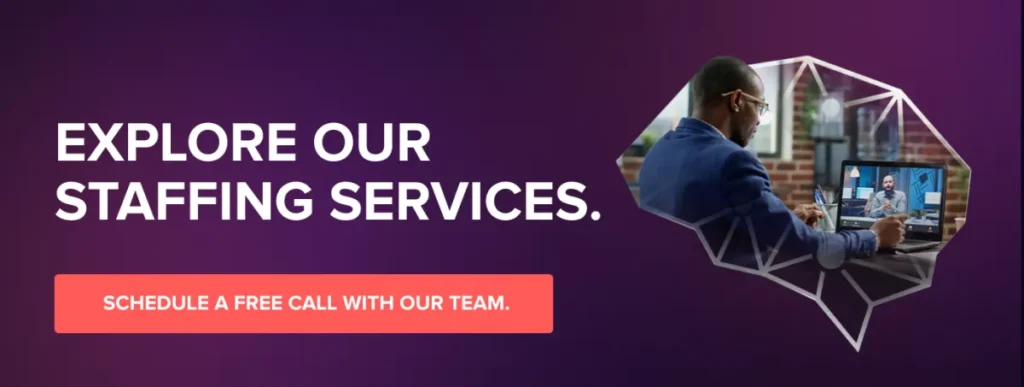Introduction

Picture a world where organizations achieve a 20% increase in productivity simply by enhancing their training programs. This scenario isn’t merely hypothetical—numerous studies confirm that effective training can significantly elevate organizational success. As we delve into the essence of this transformative potential, the role of the Training and Development Manager emerges as a cornerstone of corporate growth. It is paramount for companies to articulate this job description with precision, ensuring that the pivotal role is both fully understood and optimally implemented.
Employers seeking the optimal foundation for crafting their hiring specifications will find invaluable resources in our complimentary job description for a Training and Development Manager. This document, embodying the fundamental principles and top practices of C9Staff’s hiring methodology, serves as an exceptional template to guide your drafting process. It’s designed to streamline your recruitment efforts by providing a clear and concise framework that captures the essence of what a successful candidate looks like. Access this essential resource directly below to enhance your hiring strategy and secure the best talent for your organization.
Training and Development Manager Job Description Template

Training and Development Managers are not just facilitators of learning; they are architects of capability and enhancers of organizational culture. Their impact stretches beyond routine training sessions, influencing the very core of how a company evolves and adapts in an ever-changing business environment. Accurately capturing this role in a job description is not just a formality—it’s a strategic move that aligns the developmental objectives of employees with the growth trajectories of the organization.
This article is designed to serve as a comprehensive guide for employers who are crafting job descriptions for this key position. Simultaneously, it offers deep insights for candidates, equipping them with the knowledge to understand what is expected in this role and how to gauge if they are the right fit. The ultimate goal here is dual-faceted: to aid employers in creating detailed, effective job descriptions that reflect the true essence of the role, and to assist candidates in comprehensively understanding these expectations, thereby facilitating a perfect match that propels both individual and organizational advancement.
By the end of this guide, both employers and candidates will be better prepared to engage with the role of a Training and Development Manager not just as a job but as a crucial element in the larger mechanism of organizational success. Through detailed descriptions, real-world examples, and expert insights, this guide aims to not only inform but also inspire all stakeholders to recognize and harness the profound impact that a well-defined and effectively executed training strategy can have on personal and professional growth.
Mastering the Craft: Your Ultimate Guide to Becoming a Training and Development Manager
Understanding the Role of a Training and Development Manager

Training and Development Managers are more than just educators; they are strategic partners crucial to an organization’s success. As you delve into understanding this role, consider the extensive responsibilities they hold, which stretch far beyond the traditional confines of training. These managers are tasked with designing educational programs that are not just functional but transformative, aligning closely with the broader organizational goals. Their work includes developing curricula that are both innovative and applicable, engaging employees through dynamic training sessions, and evaluating the effectiveness of these programs through meticulous performance measurement.
The impact of Training and Development Managers on an organization cannot be overstated. Their strategic input directly enhances workforce competence, ensuring that employees are not only skilled but also motivated and aligned with the company’s vision. By shaping organizational culture, they create an environment where innovation thrives and continuous improvement is the norm. This role significantly influences employee retention rates, as well-developed training programs make employees feel valued and invested in their careers.
The effectiveness of Training and Development Managers leads to observable benefits: enhanced productivity, a stronger competitive edge, and a workforce that is agile and capable of adapting to new challenges. These outcomes underscore why a detailed understanding of this role is essential for both employers, who must craft precise job descriptions that capture the essence of the role, and for candidates, who need to grasp these complexities to truly excel in these positions.
As you, the reader, navigate through this guide, it’s crucial to see the full spectrum of responsibilities and impacts associated with the Training and Development Manager role. Whether you are an employer aiming to refine your hiring process or a candidate preparing for your career advancement, understanding these facets will equip you to better appreciate and engage with this pivotal position. This knowledge is not just theoretical; it’s fundamentally linked to practical success and organizational advancement.
For Employers: Crafting the Perfect Job Description

To start, understand that a standout job description is the foundation of successful recruitment. It should be clear, concise, and structured to attract the right candidates. A great job description does more than list duties; it communicates the importance of the role and inspires qualified candidates to apply. The key is in how you articulate expectations and define roles, ensuring that every word works towards these goals.
Fundamental Components of an Effective Job Description
Clarity and Conciseness: Every job description should be easy to read and understand, free from jargon and overly complex language. Use short, direct sentences to convey the necessary information.
Well-articulated Expectations: Clearly outline what the role entails and what will be expected from the person filling it. Avoid vague descriptions and be specific about the tasks and responsibilities.
Engaging and Inclusive Language: Write in a tone that reflects your company’s culture and values, and make sure the language is inclusive to attract a diverse pool of candidates.
Must-Have Elements of a Training and Development Manager’s Job Description
Responsibilities: List specific duties, such as designing and implementing training programs, assessing their effectiveness, and adapting them to new technologies or methodologies.
Qualifications: Specify educational backgrounds, professional certifications, and any other relevant qualifications.
Skills: Include necessary skills like leadership, communication, and expertise in learning management systems.
Special Requirements: Mention any unique requirements such as travel, flexibility to work odd hours, or proficiency in specific software.
Legal Considerations in Drafting a Job Description
Compliance with employment laws is crucial to avoid legal pitfalls. Here’s how you can stay compliant:
Avoid Discriminatory Language: Ensure that the language used does not discriminate based on age, gender, ethnicity, or any other protected characteristic.
Accurate Job Titles and Descriptions: Make sure the job title and description reflect the actual duties and responsibilities. Misrepresentation can lead to legal issues and employee dissatisfaction.
Privacy and Data Protection: Be mindful of the privacy and data protection laws when collecting and storing candidate information.
By following these guidelines and using the example provided, you can craft a job description that not only complies with legal standards but also attracts the most qualified candidates to your organization. Remember, your job description is the first point of contact with potential employees, so make it count!
Employers seeking the optimal foundation for crafting their hiring specifications will find invaluable resources in our complimentary job description for a Training and Development Manager. This document, embodying the fundamental principles and top practices of C9Staff’s hiring methodology, serves as an exceptional template to guide your drafting process. It’s designed to streamline your recruitment efforts by providing a clear and concise framework that captures the essence of what a successful candidate looks like. Access this essential resource directly below to enhance your hiring strategy and secure the best talent for your organization.
Training and Development Manager Job Description Template

For Candidates: Decoding the Job Description

As you board on the journey to potentially become a Training and Development Manager, it’s crucial to meticulously analyze job descriptions to understand what employers are looking for. Let’s start by dissecting a typical job listing to uncover the most valued skills and experiences. This will help you see beyond the basic requirements and understand what makes a candidate stand out.
Breaking Down a Typical Job Description
Educational Background:
Why It’s Critical: Most positions require at least a Bachelor’s degree in Business, Human Resources, or Education. This ensures you have a foundational understanding of theories and practices in training and organizational development.
Technical Skills:
Examples: Proficiency in Learning Management Systems (LMS), e-learning software, and perhaps basic data analysis skills.
Why They’re Critical: These skills enable you to design and implement effective training programs digitally and assess their impact quantitatively.
Years of Experience:
Range Typically Required: 3-5 years in a training capacity within a corporate setting.
Why It’s Critical: Experience shows you’ve successfully applied educational theories in real-world scenarios and understand the nuances of adult learning and development.
Assessing Your Fit and Readiness
To determine if you’re a good fit for the role, consider the following questions:
Do your career goals align with the opportunities this role presents?
Can you demonstrate past successes in similar responsibilities?
Are you ready to manage the challenges that come with training diverse teams?
These questions aim to make you reflect not just on meeting the qualifications but on thriving in the role and contributing significantly to an organization’s goals.
Bridging the Gap Between Current Capabilities and Job Requirements
If you find gaps between your current capabilities and the job’s requirements, consider the following steps:
Further Education: Look into specialized certifications in training and development, such as ATD or CIPD, which can bolster your credentials.
Professional Development Courses: Engage in workshops and courses that enhance skills in digital tools, leadership, and strategic planning.
Real-world Experience: Seek volunteer opportunities or internships that allow you to practice and refine your training skills in a practical setting.
This proactive approach is not just about meeting the requirements but about seizing an opportunity for personal and professional growth. It’s about showing potential employers not just that you want the job, but that you are continually striving to be the best candidate possible.
Throughout this exploration, remember that each step you take to understand and match a job description is a step towards your future career. By the end of this section, you should not only understand how to decode job descriptions effectively but also feel equipped and inspired to enhance your qualifications to reach your career aspirations.
Candidates eager to supercharge their career and land their dream job are encouraged to explore the opportunities C9Staff has to offer. Click the link below to submit your resume to our talent acquisition department. If your qualifications align with our client’s requirements, we will reach out to discuss potential opportunities that match your skills and experience. Don’t miss the chance to advance your career with C9Staff, where we connect exceptional talent with outstanding opportunities.

Essential Skills and Qualifications

As you set your sights on becoming a Training and Development Manager, it’s crucial to recognize the importance of a well-rounded skill set. This role demands more than just knowledge; it requires a blend of core skills that are essential for both the daily tasks and the long-term success of any training initiative.
Core Skills Necessary for Success
Strategic Planning: As a Training and Development Manager, you will need to design training strategies that align with organizational goals. This might involve creating annual training plans or adapting training methodologies based on company objectives. For example, if your company aims to expand into new markets, your role would include developing cultural competence training for employees to ensure smooth transitions.
Effective Communication: Your ability to communicate clearly and persuasively will be key. This encompasses everything from presenting training modules to writing detailed reports that justify the ROI of training initiatives. Imagine you are trying to get buy-in from upper management for a new training program; your success will hinge on your ability to articulate the benefits and potential impact clearly.
Leadership: This skill is indispensable. You’ll not only manage training programs but also lead a team of trainers. Leadership involves mentoring staff, resolving conflicts, and driving the team towards common goals. Consider a scenario where team motivation is low; your task would be to inspire and lead by example, fostering a positive and productive work environment.
Desirable Qualifications That Give an Edge
Enhancing your resume with higher educational credentials or specialized certifications can significantly boost your career. For instance, obtaining a Master’s degree in Educational Leadership or Human Resources can provide you with advanced knowledge and skills that are highly attractive to potential employers. Certifications such as the ATD Certified Professional in Learning and Performance (CPLP) or the SHRM Certified Professional (SHRM-CP) not only deepen your expertise but also signal to employers your commitment to staying at the forefront of your field.
Additionally, experience with advanced training technologies, such as virtual reality (VR) training systems or sophisticated e-learning platforms, can set you apart. These technologies are becoming more prevalent, and your ability to implement them effectively can make you a valuable asset to any organization.
The Importance of Continuing Education and Certification
In the ever-evolving field of training and development, continuous learning is not just beneficial; it’s necessary. Staying updated with the latest training methodologies and technologies ensures you remain competitive and effective. Participate in industry conferences, subscribe to relevant journals, and enroll in workshops and courses that focus on emerging trends, such as digital transformation in training or the integration of AI in learning environments.
Programs such as the International Association for Continuing Education and Training (IACET) accredited courses can provide you with cutting-edge insights and practical tools to enhance your training programs. These credentials are not just educational; they are a testament to your dedication to your professional growth and to maintaining a high standard of excellence in your work.
By embracing these core skills, qualifications, and the path of continuous education, you are not just preparing for a job but are paving the way for a dynamic and rewarding career in training and development. Let this guide serve as your roadmap, and remember, every step you take is a step towards achieving your professional aspirations in this vital field.
Trends and Future Outlook

Step into the future of Training and Development as you explore this dynamic section, where the landscape is rapidly evolving with the advent of digital transformation and remote training capabilities. These trends are not just reshaping the tools we use but are fundamentally revolutionizing the way training programs are designed and delivered. For instance, the integration of artificial intelligence is creating personalized learning experiences that adapt to the pace and style of each learner, significantly enhancing the effectiveness of training outcomes. Additionally, virtual reality is being used to simulate real-life scenarios, allowing trainees to practice skills in a safe, controlled environment that mirrors real-world challenges.
As we look ahead to the next 5-10 years, certain skills will become crucial for Training and Development Managers. Data analytics, for example, will be essential for measuring the effectiveness of training programs and making informed decisions based on factual insights rather than intuition. Digital literacy will also be paramount as new tools and platforms continue to emerge. Mastery of these technologies will not only be required for the creation and delivery of content but will also be critical in managing the infrastructure of increasingly digital learning environments.
To advance in this evolving field, current Training and Development Managers should consider several proactive steps. Pursuing advanced degrees or certifications focused on emerging technologies can provide a deep understanding of future trends and prepare you for leadership roles. Continuous professional development, through workshops and specialized training, can help keep your skills sharp and your knowledge up-to-date. Viewing these advancements not just as challenges, but as opportunities to enhance your impact, will enable you to lead your organizations towards greater success and resilience in the face of technological change.
This section encourages you to not just passively observe the transformation in the field of Training and Development but to actively engage with it. Embrace these changes with a mindset geared towards continuous learning and improvement. By doing so, you position yourself at the forefront of your field, ready to navigate the complexities of tomorrow and empower others through effective, innovative training strategies. Remember, the future is not just something you adapt to; it is something you actively shape through your actions and decisions today.
Employers looking to source, recruit, hire, train, manage, and deploy the ideal candidate for a Training and Development Manager within their organization are invited to explore the comprehensive services offered by C9Staff. Click the link below to schedule a free exploratory call with one of our account managers today. During this call, we will carefully listen to your specific needs and provide endorsements for potential candidates at no cost, helping you evaluate the best talent available at competitive prices. Don’t miss this opportunity to enhance your team with the perfect fit through our expert guidance and support.

Conclusion

As we conclude this comprehensive guide on the role of Training and Development Managers, let’s succinctly recap the critical insights and actions needed for success in this pivotal position. Training and Development Managers play a fundamental role in enhancing organizational success through effective training strategies. Their ability to craft and execute these strategies directly impacts not only individual employee growth but also the overall health and productivity of the organization.
Employers, it’s crucial to craft precise job descriptions that reflect the true demands and expectations of this role. This accuracy ensures you attract candidates who are not only qualified but also fully aware of what their responsibilities will entail, leading to better job alignment and satisfaction.
Candidates, understanding these descriptions thoroughly allows you to assess your suitability and readiness for such roles. It’s about more than meeting the requirements; it’s about foreseeing a future in which you thrive by leveraging your strengths in strategic planning, effective communication, and robust leadership.
Furthermore, both employers and candidates must remain agile learners, staying updated with the latest trends such as digital transformation and the growing importance of data analytics in training. Continuous education and certification in these emerging areas are paramount.
Now, let’s act. Employers, I encourage you to utilize the insights from this guide to refine your hiring processes, ensuring you attract and retain the most capable Training and Development Managers. Candidates, proactively evaluate and prepare for your career progression by aligning your skills and experiences with the evolving demands of this dynamic role.
Remember, excellence in training and development is not a static achievement but a continuous journey. Whether you are drafting the perfect job description or preparing to fill that role, every step you take is towards a future where you not only meet but exceed the standards of what effective training can achieve. Let’s move forward with confidence and commitment to excellence.




